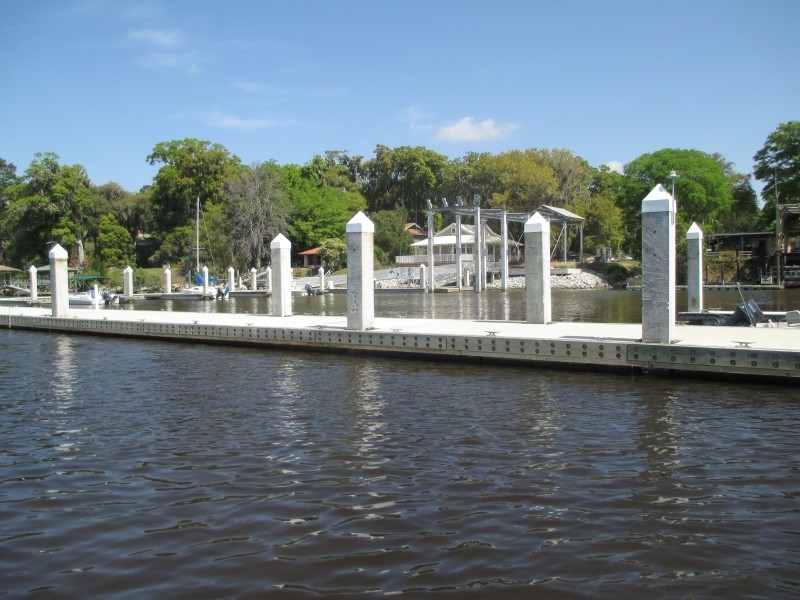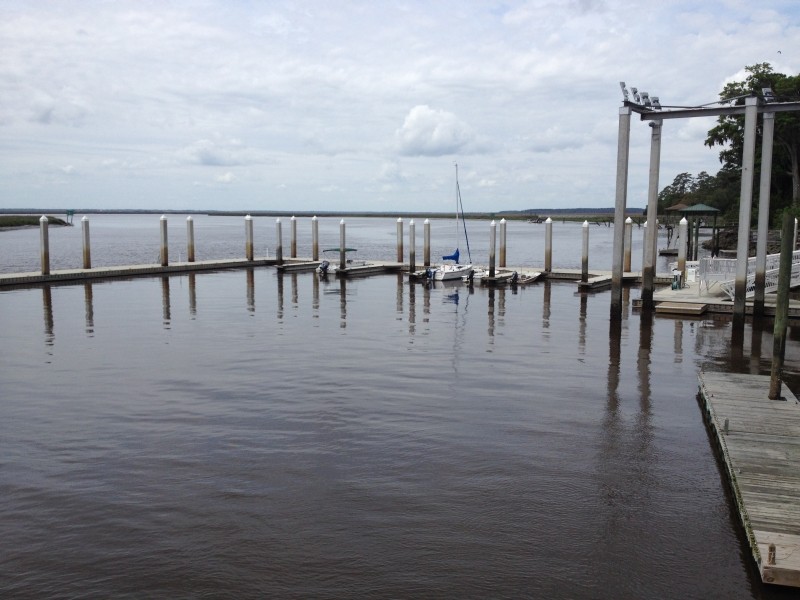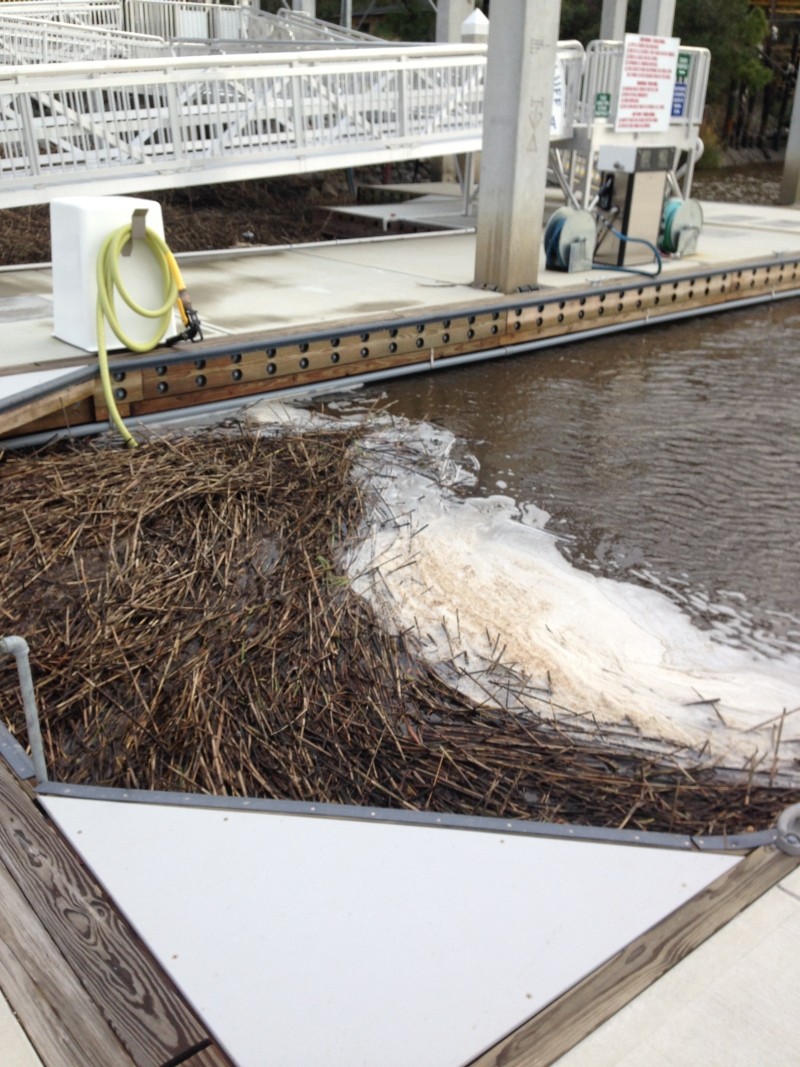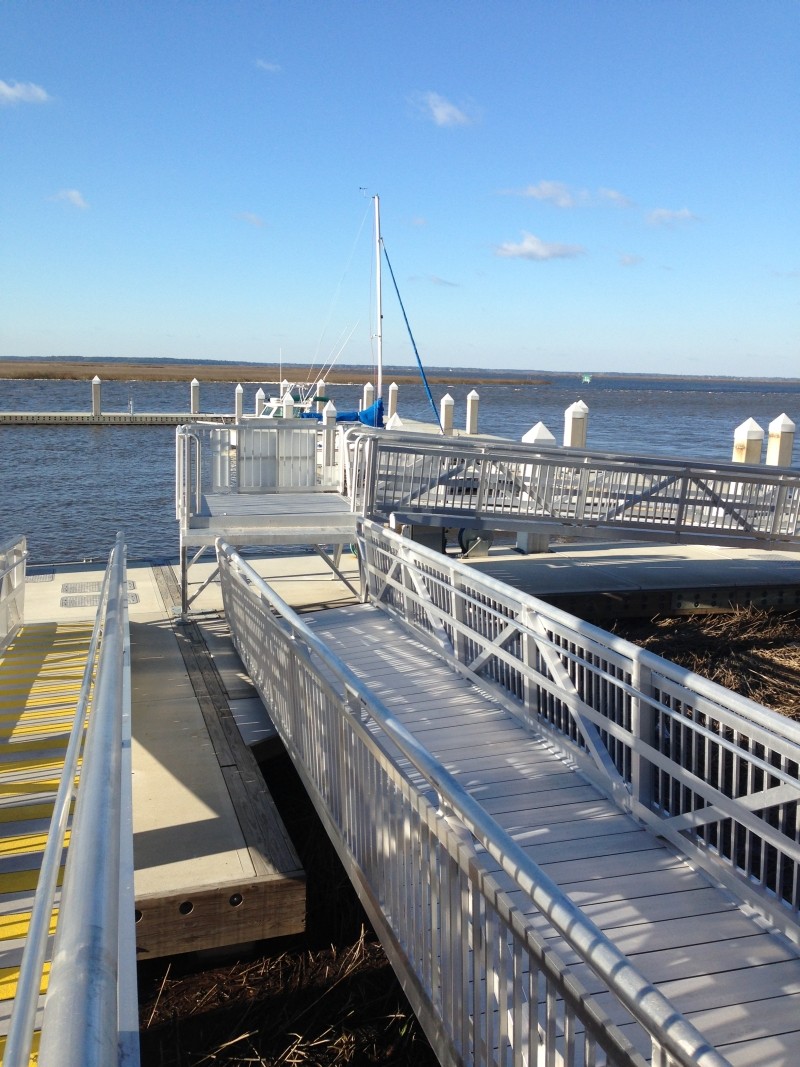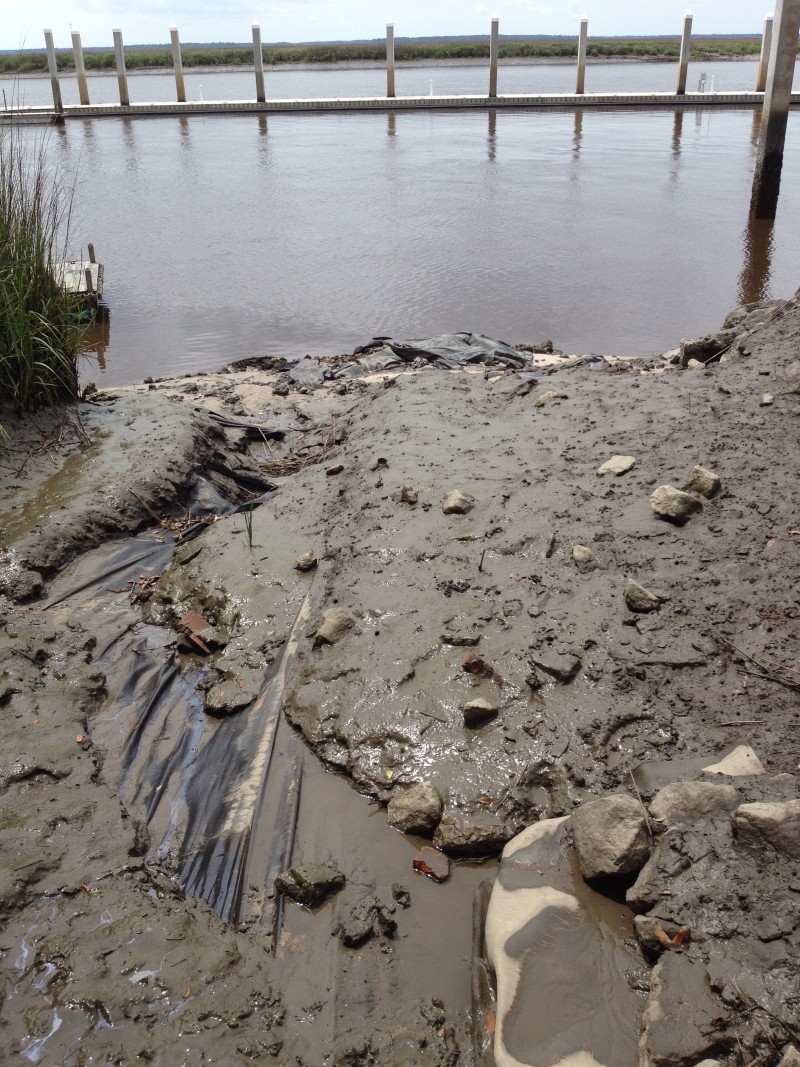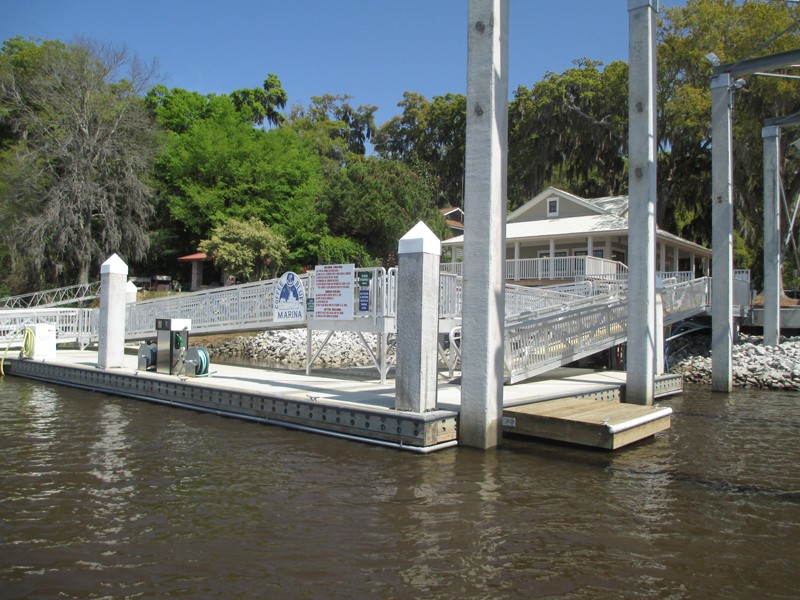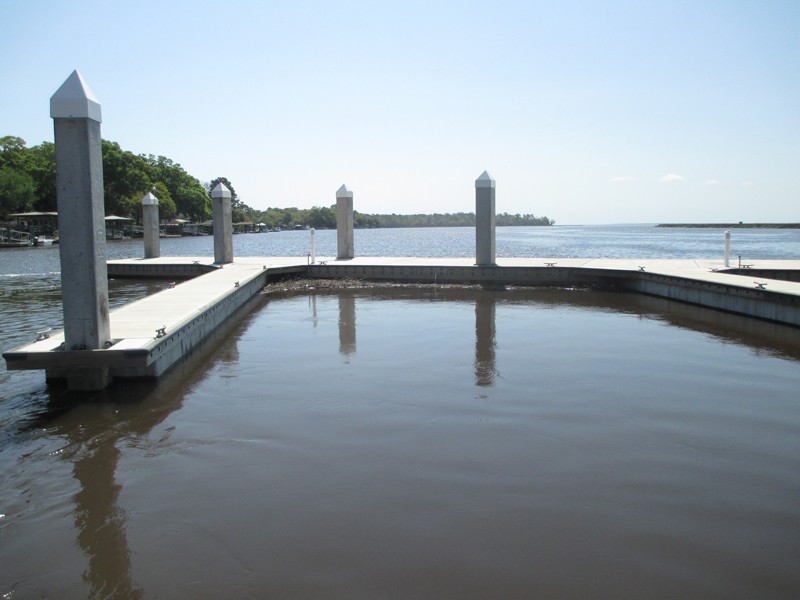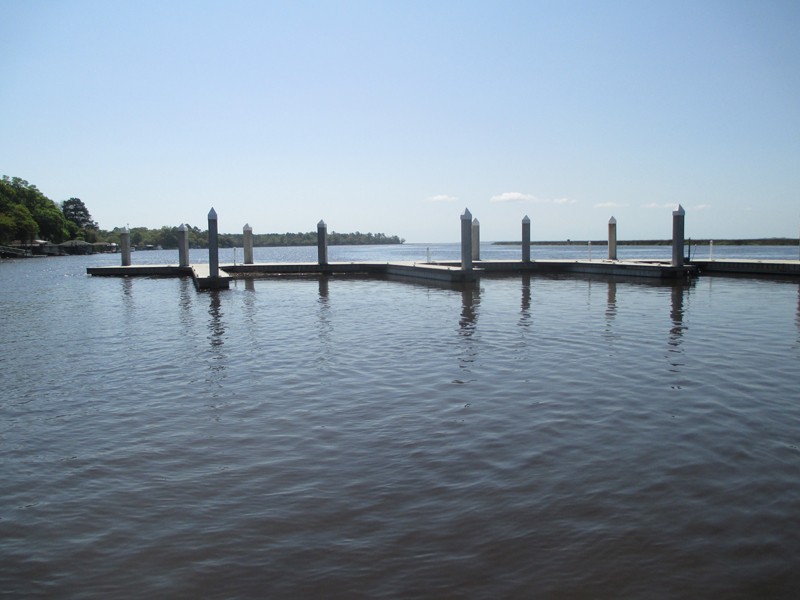TONY THOMAS, the City of Savannah alderman who spearheaded its makeover, calls the new Coffee Bluff Marina the "crown jewel" of Savannah parks.
Located on a scenic and moss-lined dead end about two miles after White Bluff Road changes into Coffee Bluff Road, Coffee Bluff Marina is Chatham County’s only publicly-owned marina.
But the marina operator recently fired by the City after five frustrating years of attempting to manage it during the on-again, off-again rebuilding of the facility calls it something else.
“It’s a $5 million concrete dam,” says Ray Golden.
Among other things, the story of Coffee Bluff Marina is a story of:
• $50,000 lights you can’t use after dark
• A collapsing handicapped ramp
• A treacherous boat hoist
• A useless fishing pier
• An unusable kayak launch
• An unreachable gas pump
• Environmental issues
• Cost overruns
• Potential conflicts of interest
And stubbornly elusive promises of electric power to the docks, i.e., shore power, which was present in the original Marina and in the plans for the rebuild, funded and then eliminated several times, and still nowhere near installation a month after the Marina’s second “grand re-opening” this past March.
You need never have stepped aboard a boat to see the story of Coffee Bluff Marina as a cautionary tale of good intentions run amok, bureaucracy run wild, and of the importance of oversight of your tax money —which in this case often seems to flow as freely and uncontrollably as the notoriously fast and swirling currents of the beautiful Forest River itself.
PEOPLE ARE QUICK to assume that marinas and boats and such are the province of the rich. But in a place like Savannah—amidst one of the most gorgeous maritime environments on the East Coast—that’s not always the case.
Many natives here grow up within stone-skipping distance of a river or a creek. For them the smell of the marsh, the vibration of a revving Mercury, and the sound of water skimming up against the hull of a fast-tacking Catalina are anything but “elite.”
People of all ages move here from around the country to enjoy life on the water, and for them a boat isn’t a luxury item but a key part of that lifestyle.
Dr. Jerry Case, a local veterinarian whose family-run practice here is a century old, lives right next door to Coffee Bluff Marina. He talks about the importance of it to the community fabric.
“When they wanted to turn all this into condominiums, I was among those around here that were against that,” Case tells me one afternoon on his simple wooden dock, a few yards from the Marina.
“We wanted to see a marina remain here, but I’ve always wanted it to be open to the public—for the public’s use, and for the neighborhood’s use.”
Case got his wish in 2008 when the City of Savannah purchased Coffee Bluff Marina for $1.5 million from Harold Javitz, whose plan for an extensive waterfront condo development thankfully never came to fruition.
“To understand Coffee Bluff Marina you have to go back 20 years ago to all the fights between other landowners and Javitz,” says Alderman Tony Thomas.
“That was probably the most convoluted piece of property in Chatham County. It had squatters, it had areas of land dedicated in the 1890s for a city park, it had a roadway right down the middle of it. There was over a decade of fighting over it.”
Thomas and then-City Manager Michael Brown eventually helped broker the purchase to ensure public access to the water.
“Over the years numerous public landings just disappeared,” says Thomas. “Many were used by African American fishermen in the 1800s and early 1900s. But as people started moving into Coffee Bluff, those fishing rights sort of got lost in translation.”
Several million dollars had already been appropriated for “Southside Parks and Recreation” in one of the SPLOST (Special Purpose Local Option Sales Tax) initiatives.
Thomas and Brown diverted the money from an unsuccessful Windsor Forest/Wilshire project in order to fund the purchase and rebuild of Coffee Bluff. City Council approved it unanimously.
Before the rebuild, the Marina continued as a simple facility with a dirt parking lot and a dedicated group of patrons with a wide variety of watercraft, very few of them ostentatious in any way.
Affordable slip space being at a premium, the old Coffee Bluff Marina used to be full of boats.
When I talk to Jerry Case, however, only three boats are tied up at the huge new dock.
“And one of them belongs to an employee,” Case says.
“I don’t doubt that some people are staying away because of all the negative publicity,” says Matt Starling, current interim manager of the Marina.
“Frankly I might feel the same way myself. But as of right now I look at it as a prime opportunity for people to sign up,” says Starling, who is among those submitting a proposal to be awarded the permanent contract to run the Marina.
In a pursuit often seen as catering to the rich, a publicly-owned marina sends a strong message—not only to Thomas’s constituents but to all of Savannah—that the water is a resource to be enjoyed by all.
Perhaps unfortunately, taxpayer-owned status also means the City of Savannah runs the Marina. And for some, that has been an insurmountable problem.
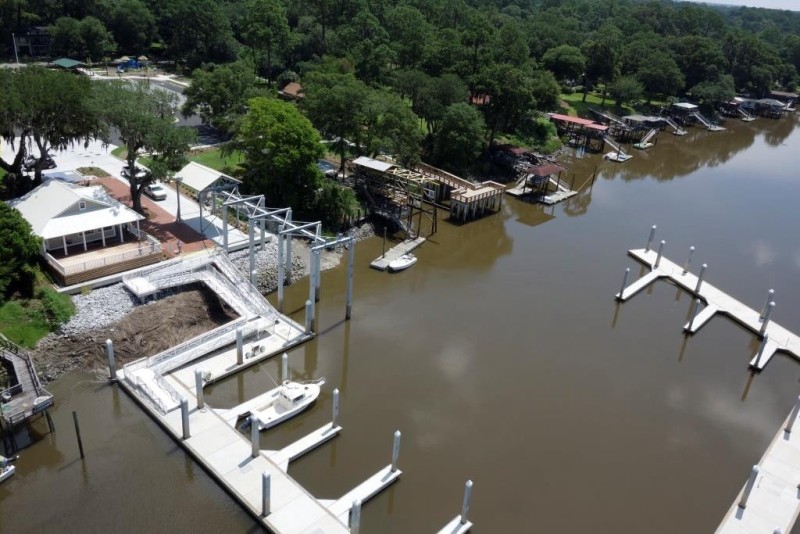
IN MARCH 2009, Ray Golden, with 20 years professional experience working in and around the water, was awarded the City contract to rejuvenate and operate Coffee Bluff Marina. To do so he had to sell his bait and tackle business on Tybee.
“Then three weeks before we were to begin the contract, the City came back with a new contract as they didn’t sign the original,” Golden claims.
Then came the first of many unpleasant surprises for Golden, when he heard the City’s idea to tear down two outbuildings at the Marina, one of which was used for “dry storage,” i.e. a place for boat owners to store their boats out of the water.
“Storage is what pays your bills at a marina,” says Butch Broome, who owns and operates Ft. McAllister Marina in Richmond Hill, a short 15-minute boat ride from Coffee Bluff.
“Launching boats and selling bait help, but storage rental is what carries you through the winter,” Broome says.
Golden says, “Had they told me a week earlier they were going to do that, I would have walked, but based on our agreement I had already sold my business on Tybee and there was no going back.”
This type of Catch-22 would soon become familiar to Golden, who found himself tasked with turning a profit at an unfinished marina where sources of revenue were either not delivered or simply removed.
Golden would even later be accused in the media by City of Savannah Leisure Services Director Joe Shearouse of having made a “bad business decision”—the bad decision presumably being going into business with the City in the first place, on terms dictated by the City.
(Shearouse and City Manager Stephanie Cutter declined requests to comment for this article.)
Golden says the City terminated his contract this past March not for performance reasons, but because he was a whistleblower on design problems and cost overruns.
But six years ago, Golden’s Kafkaesque experiences with City bureaucracy were just beginning.
DURING 2009 and 2010, Ray Golden says he and his wife put about $55,000 of their own money into the Marina, improving flotation on the old wooden dock and making it usable.
“In some places water was washing up over the dock,” he remembers.
Then in November 2010, Golden says, “Tony Thomas came to us and declared he just received $4.3 million budgeting to tear down the old marina and rebuild from the ground up.”
Key firms involved in the rebuild included main consulting firm EMC Engineering Services; H+K Engineering, who designed the master plan; and Weimar Construction, who performed the work; among others.
In July 2011, City Council awarded a $190,000 contract for architectural consulting to EMC Engineering.
Serving on City Council at the time was Larry Stuber, former president of...
EMC Engineering.
Stuber had just announced his bid for reelection. Once jokingly referred to by former Mayor Otis Johnson as “Council Resident Engineer,” Stuber sold his stake in EMC in 2006 but was still on its Board of Directors as late as 2008, right before running for his first Council term.
In Jan. 2012, EMC Engineering got another bump from the City, a $63,000 contract modification. Among the listed additions was a “boat storage shed,” i.e. the dry storage mentioned above that Golden deemed necessary to turn a profit.
Tony Thomas insists the old storage shed was “rundown and rat-infested.” In any case, despite taxpayers funding a new one, there is no boat storage shed nor any dry boat storage of any kind available at Coffee Bluff Marina, nor is any planned to this day.
Claiming that “neighbors were against the boat storage shed,” City of Savannah Public Information Director Bret Bell says that “the engineer also designed a screened multi-purpose room and boat storage area, both of which were not included in the subsequent construction contract as one of our cost-reduction measures.”
The honeymoon’s over between the City and EMC. The City of Savannah is now demanding over $297,000 from the once well-connected firm, whose former president no longer serves on City Council.
“We have sent a letter of demand to EMC concerning cost increases as a result of necessary changes to the bulkhead, and do plan to litigate if not resolved to our satisfaction,” says Bell.

THE MARINA NOW boasts a brand new hoist, the purchase and installation of which runs in the multiple hundreds of thousands of dollars. Golden maintains it wasn’t a necessary purchase.
“The old hoist was capable of handling 20,000 pounds, and the engineer stated it should be condemned because there was no way the pilings would sustain continued use at that level,” Golden says of the condemnation of the old hoist.
“But the average size boat that puts in at Coffee Bluff is only 2,000-3,000 pounds. You could barely bring a 20,000 pound boat down this river at all,” he says.
“Hell, you could barely tow a boat that big down Coffee Bluff Road. It would need a police escort.”
Tony Thomas, however, says flatly that “the old hoist swayed when you had a boat on it. It was structurally unsound, and that’s why it had to be replaced.”
During the time the hoist was being changed, Golden estimates he lost at least $14,000 in revenue—one item on a long list he has compiled of examples of lost revenue during the construction period.
When the new hoist was installed and the Marina prepared for its first “grand reopening” in August 2014 —two years after the $4 million contract was awarded to Weimar Construction and five years after the $1.5 million land acquisition—Golden made another disturbing discovery.
“You had to make at least an eight-foot leap from the dock to get on your boat, or either get a super long hook and pull your boat so you can step aboard,” Golden says.
(Golden posted a humorous video on Facebook in the style of the famous courtroom scene from JFK: “From there ... to the boat ... from there ... to the boat ...”)
Unwilling to let customers assume the very real risk of falling in the water and getting pulled under the dock by the Forest River’s tricky currents, Golden took it on himself to build a wooden platform dock to bridge the gap.
The City purchased the materials for the dock. But Golden and Jerry Case had to build it themselves. It’s still in use today.
Starling isn’t sure for how much longer, though. “But we’ll always have an employee there to help you get on and off your boat,” he says.
Ironically, there would be problems later on with the pilings, though not due to the hoist, resulting in the demand letter to EMC.
The money the City wants back is due to a July 2013 $300,000 contract modification to install deeper pilings for seawall bulkheads when it was discovered that the original pilings were too shallow to support the structure.
New, deeper bulkheads had to be designed, sent, and installed, further delaying the Marina opening another 100 days.
While doing the first soil boring tests to determine the needed depth—tests which proved inaccurate—the engineer hit and burst the main City water line to the Marina.
The City billed Ray Golden $500 for the extra water.
ANY CIVIC PROJECT anywhere will have its share of human error, cost overrun and design issues.
But the wrack issue at Coffee Bluff points to a possibly fatal design flaw.
The new Marina design has dramatically increased the amount of wrack, or dead floating marsh grass, accumulating around the dock—leading to Golden’s quip about a “$5 million concrete dam.”
“As soon as we saw the design we knew it would be a flop, because of the wrack buildup on a tidal river,” agrees Butch Broome of Ft. McAllister Marina.
Unlike the “old” Coffee Bluff Marina and every other area marina—Hogan’s, Isle of Hope, Ft. McAllister, etc.— the new dock doesn’t run parallel to shore, but perpendicular.
“The reason you build marinas like you do is because of wrack,” says Broome. “A concrete dock like they have there now just literally dams the river up.”
Indeed, there are unconfirmed reports from residents downriver that their docks are now beginning to silt in due to the dam-like action of Coffee Bluff Marina upstream.
At Coffee Bluff these days, wrack now forms very sizeable frothy clumps which are not only hazards to navigation and water flow, but are notorious sand gnat and mosquito spawning grounds.
Worse, if wrack accumulates it begins a deadly cycle of smothering and killing live wetlands—which in turn creates more wrack and kills more wetlands, etc.
Starling says there’s an easy answer.
“It’s called maintenance. It’s a little bit of a design flaw, but the grass isn’t hurting the dock. It’s nothing a little simple maintenance can’t fix. It’s like washing bird crap off the dock.”
Alderman Thomas says the wrack issue is a “smokescreen.”
“If the operator is properly pushing wrack out, it’s not an issue. Since the temporary operator has been in there it hasn’t been a problem,” he says.
“The old dock had a wrack problem as well, and contrary to what people are saying, other marinas do have wrack issues.”
THE THING GOLDEN says really led to his dismissal is the issue of the collapsed handicapped ramp.
Golden says that in August 2014 he alerted the City that the handicapped ramp was not secure. “Nobody would accept responsibility.”
Their solution, Golden says, providing photographic proof, “was to take a black crayon and outline the platform legs to monitor movement.”
That November, Golden remembers, “as I was plumbing my bait tanks along this ramp, the roller balls came off and the ramp fell, but caught on a lip. I was inches from the ramp.”
This time, hydraulic jacks were used under the gangway to reposition it. A few months later, Golden called the City “and told them it looked suspect due to a big spring tide.”
Golden says he requested an audience with Joe Shearouse’s department to warn of another impending 12-foot tide swing which might displace the ramp.
“They responded with a Demand Letter for past due rent,” Golden says. (The issue of who owes who for rent is an ongoing theme with Coffee Bluff Marina.)
The morning of Feb. 18, 2015, Golden wrote in an email to various City officials:
“This morning their mangled ramp nose dived. Fortunately nobody got hurt. This is a situation that could have seriously injured or killed somebody,” Golden wrote.
“In my professional opinion, which is a result of 20+ years in this business, Coffee Bluff Marina is unsafe, unsound, and most certainly nonfunctional.”
A month after that email, Golden’s contract was terminated.
THERE IS NO HUMOR in the collapse of a handicapped access ramp.
But three other Marina assets—the fishing pier, the kayak launch, and the hoist lights—reach Monty Python levels of absurdity.
What’s now called a fishing pier was originally labeled an “observation deck” in H+K Engineering’s plans (the company website still features the original blueprints.)
After the public viewed those plans at a Dec. 2011 neighborhood meeting, some residents say the deck became a pier extending further out than they expected.
“The original plans call for an observation deck coming out to about there,” points Case to an area on the bluff. “As you can see, it extends out much further than that.”
Bell disputes that characterization.
“There were no changes, aside from possibly a name change at some point,” says Bell. “The design of the observation deck has remained constant throughout, and always intended to view the waterfront and allow fishing and crabbing.”
In any case, due to the pier’s construction and the current, “there are no fish there for anyone to catch,” says Golden, an experienced competitive fisherman. “You cannot catch fish from that pier.”
Case, whose property line is a few feet away, agrees: “There’s no structure for the fish to school around. I haven’t seen anyone catch anything so far.”
However, the real problem is that the pier is jammed so tight into the Marina and onto Case’s property that not only does the pier itself interfere with navigation and docking, people casting from the pier often end up getting their lines snagged on docked boats, or even on boats coming to and fro.
Case shows me a bait bucket full of tangled fishing line and leads.
“People cast off that dock and don’t realize the current will quickly take that line 40-50 feet out,” Case says.
“You’ve got a propeller on a docked boat sitting there spinning in the current, the fishing line snags it and breaks, the propeller wraps the line around for hours, and then you get all this here,” he says, pointing to the bucket full of line he had to cut off a propeller the day before.
Golden says the fishless fishing pier that blocks the docks is a perfect symbol of the dysfunction of the new Coffee Bluff Marina.
“The pier cost the city $400,000. The revenue functionality of the Marina that was cut out of the budget was all less than that amount,” Golden says.
Matt Starling, current Marina manager, says, “I’ve met with the City and we’re going to be building a structure to attach to the dock. Within 30 days there will be a fence on the east side of the dock so people won’t be able to cast off the east side.”
The “kayak launch”—for which one fee table calls for a $5 charge per use—is little more than a narrow drainage ditch with culvert, between the Marina and the Coastal Marine Rescue Squadron Dock (itself between the Marina and the pier).
At low tide the mud is too deep to step in. A haphazard roll of heavy cloth forms an ineffectual and unsafe platform.
Golden says the City’s idea to make the kayak launch serviceable was simply to dump a truckload of sand at the waterline —which of course immediately washed out into the river.
“I told them that sand would last as long as the next high tide,” he says. “A child could have told them that. They didn’t listen.”
One observer says the City’s sand dumps at the kayak launch constitute “flagrant violations” of the City’s Corps of Engineers permit, its Storm Water Discharge permit from Georgia EPD, its Sediment and Erosion Control permit, its 401 Water Quality certification and its Coastal Zone Management certification.
Starling says there will be a low-budget “easy fix” for the kayak launch involving a cubicle, a small floating dock—and yes, maybe more sand.
“Look, there’s nothing on this river that can’t be eroded. Whatever you don’t anchor down will wash away,” Starling says.
This isn’t the first environmental issue at Coffee Bluff. During the sinking of the problematic pilings, engineering contractor Myrick Marine “discovered and excavated some rock and concrete debris,” says Bell.
The contractors “set those to the side in the water instead of pulling it to land, and the DNR deemed this to be dredging,” Bell says. “DNR fined Myrick $11,000 and the City as property owner $11,000.”
The new Marina boasts extremely bright floodlights mounted on top of the hoist illuminating the docks, akin to stadium lights.
A total of $83,000 went to pay for these lights and other electrical improvements, with the bulk going to the lights themselves.
There’s one problem: The lights can’t be used after dark. Their brightness has caused too many neighbor complaints.
Here’s the real kicker:
Because Coffee Bluff Marina is a City park, it can’t be used after dark anyway.
“This is a residential neighborhood, and the Zoning Ordinance limits use of the boat hoist and dockage to a half hour before sunrise and a half-hour after sunset, which in summer is between 9 and 9:30 p.m.,” clarifies Bell. “This was discussed with potential bidders during the pre-bid conference.”
IN A 2011 EMAIL, City staff lauded Ray Golden and his wife as “great ambassadors” of the Marina.
Later that year, Golden sent an email to City staff referring to the “near financial disaster” of the Marina’s lack of profitability and begging for their help.
Writing “it has gotten really ugly,” Golden pointed to the out-of-action hoist, the unfinished store, and the lack of an accessible fuel pump for larger boats.
Golden said a typical Thanksgiving Day weekend should bring $5,000 in revenue, but Thanksgiving 2011 he only totaled $800 over three days.
The City’s response is that Golden didn’t “market” the Marina to boaters—though one of Golden’s frequent requests was for signage along the Intracoastal Waterway.
“During construction, the City of Savannah paid Mr. Golden for two years to do nothing, as we had a good experience with Mr. Golden prior and desired to keep him as the operator, and delays in construction were no fault of his own,” says Bell.
“During this period, there were no signs that Mr. Golden took advantage of this downtime to develop business or marketing plans, or do any other work, to increase sales at the Marina when it opened,” Bell says.
Golden counters that there wasn’t much to market, and if he was paid to “do nothing,” it was only because the City was so slow to move and the design of the Marina so compromised.
“I told them that over and over, but they cut out any chance for the Marina to have shore power, cleats, fuel to the outside, dry storage, or basically all the things that make a marina a marina.”
As far back as 2011, Golden was requesting all those items, when there might still be time to install them.
But in spring 2014, while preparing to reopen the first time, Golden got the news that despite whatever amenities had been budgeted and removed and budgeted again, virtually none of it was going to happen.
Golden emailed City staff in even more dire language:
“I fear that we are headed for a major financial catastrophe with the elimination of all the revenue-making possibilities that we counted on in the original plans.... I have toiled with the cash flow projections almost daily for the past eight months and I absolutely see no way that I can meet these (rent) payments.”
Jack Simmons is a local boater with extensive experience sailing in and out of the often tricky waters around Coffee Bluff. A veteran of the old Coffee Bluff Marina, he is one of a handful of customers currently renting space at the rebuilt facility.
Simmons makes it clear he supports the Marina. “I want to see it succeed, and I think it eventually will.”
But, “I wouldn’t say this was the best design they could have gone with.”
A big problem with marketability for Coffee Bluff, Simmons says, is the placement of the fuel pump, located as deep into the interior of the dock as it can get, with no room for a larger boat to pull up without blocking the hoist.
“What you really need to get people to come in off the Intracoastal Waterway is to make it easy for them to just tie up on the outside, fill up the tank, maybe pick up some beer, and gun it right out of there again,” Simmons says.
“Then you could put up some signage and have something to offer.”
Broome of Ft. McAllister Marina agrees.
“At every other marina, the fuel is along the outside of the dock. If you’re fighting a 7-8 knot tide, it’s almost impossible to get to the pump at Coffee Bluff,” he says.
“I have people come over to my marina all the time to get fuel, saying it’s too much of a pain in the ass at Coffee Bluff.”
Thomas says the City is looking at adding fuel to the outside.
“I’ve heard that complaint, and I don’t disagree. It’s a great idea.”
DESPITE THE FACT that the old Marina had shore power, despite the fact that the plans for the new Marina called for shore power, despite the fact that eliminating the fishing pier and lighting system could easily have funded the installation of shore power ... the City still says the shore power dispute is all on Ray Golden.
“Mr. Golden knew heading in that while we desired to have shore power available for boat hookups, we weren’t going to be able to include it immediately,” Bell tells Connect.
“He was aware that while we desired to bring in shore power, there were no short-term plans to do so. He signed the contract anyway,” Bell says.
Thomas says: “I didn’t know about shore power being cut out of the budget. When I first heard about it being cut, I spoke with Leisure Services and they said they’d come back and do power in a separate contract.”
Like the alternator in a car, shore power enables a boat to recharge its batteries while docked. Even more importantly for larger boats, to run its bilge pumps.
“A typical sport fisherman’s boat has six batteries that cost maybe $250 apiece,” says Broome. “If those go dead, you’ve got a problem. So yeah, shore power is a necessity.”
From a sailor’s perspective, though, Jack Simmons says, “Shore power is nice, but you don’t need it. If the goal really is to make the Marina as widely accessible to the public as possible, one way to do that would be not to have shore power and discount accordingly.”
Golden says the money that went to the mostly useless stadium lighting could easily have been diverted to finish the long-promised shore power.
“From August 9, 2014, until my last day March 15, 2015, we had to turn away $7,200 per month in revenue because the vessels looking for docking space could not dock without shore power.”
Bret Bell counters: “The $83K was used to install flood lights to illuminate the dock, and install pedestal lights to the dock walkway and solar-powered navigation lights ... This part of the project, however, did install infrastructure that would facilitate the future addition of a shore power system.
“We couldn’t do everything we wanted initially, because we didn’t have money to do everything we wanted. We had to make choices,” Bell says.
In Golden’s mind, the City’s choices are exactly the point. As far as taxpayer money for shore power is concerned, he says “They stole it twice.”
SO AFTER a nearly $5 million rebuild —about $1 million of which is overrun—and the original $1.5 million land purchase, Coffee Bluff Marina will still require significant taxpayer money into the future.
Another RFP (Request For Proposal) from the City of Savannah closed out this week, on April 21.
You guessed it: Shore power is back on the menu again.
Current Marina interim operator Matt Starling is submitting a bid.
“The City has a plan to put shore power in within the next 60-80 days. The bid is out and the terms are finalized,” Starling says.
The bid scope for shore power reads in part: “This work to include installing both the power pedestals and the fire pedestals along with all necessary wiring and electrical equipment.”
Though Ray Golden was compensated by the City for his time at the Marina for much of the time it wasn’t able to operate, he claims the City fell into arrears, reneged on their agreement, and owes him more money.
That complicated dispute, totaling around $300,000, will likely end up in legal proceedings, potentially resulting in another bill for taxpayers to foot.
The City, not surprisingly, insists on looking ahead.
“This facility, like all facilities, is a work in progress,” says Bell. “It is without question that the marina we have today is a massive improvement over the marina we had four years ago, which was on the verge of condemnation.”
“Let’s be fair,” echoes Thomas. “Look at the trash that was there before. Look at what we have now. What we have now is far superior to anything that was there before.”
Starling agrees.
“We have to start looking at the positive. The City made their mistakes. Now it’s time for everybody to take all that crappy dirty laundry and throw it in the trash,” he says.
Butch Broome says the solidarity of the boating community will remain regardless of what happens at Coffee Bluff or who ends up running it.
“Marinas aren’t like convenience stores, where they’re fighting all the time. We all tend to help each other when one of us needs help,” Broome says.
“I guess it goes back to when you’re out at sea, it doesn’t matter who’s upset with who, if somebody’s in trouble you all help them out. It’s the same with marinas.”
While most everyone agrees a functioning, healthy Coffee Bluff Marina is in the public’s best interest, the way the City went about the public’s business at Coffee Bluff clearly raises serious questions about the City’s ability to manage your tax money on larger upcoming projects, such as the already-troubled $50 million Cultural Arts Center and the controversial plan for a $120 million Westside Arena.
Tony Thomas concludes:
“The City isn’t deaf. We hear what people are saying,” he says.
“We know there were some design issues. Coffee Bluff isn’t perfect and there have to be some improvements. Those improvements will be continuously made.”
Broome sums it all up pretty well:
“I don’t have a dog in the fight. But I think the City of Savannah should just suck it up and admit to its mistakes. They should just come out and say ‘We screwed up,’ instead of deny-deny-deny like they’re doing now,” he says.
“But then there’s the question of where do you find another million dollars to fix it all.”

